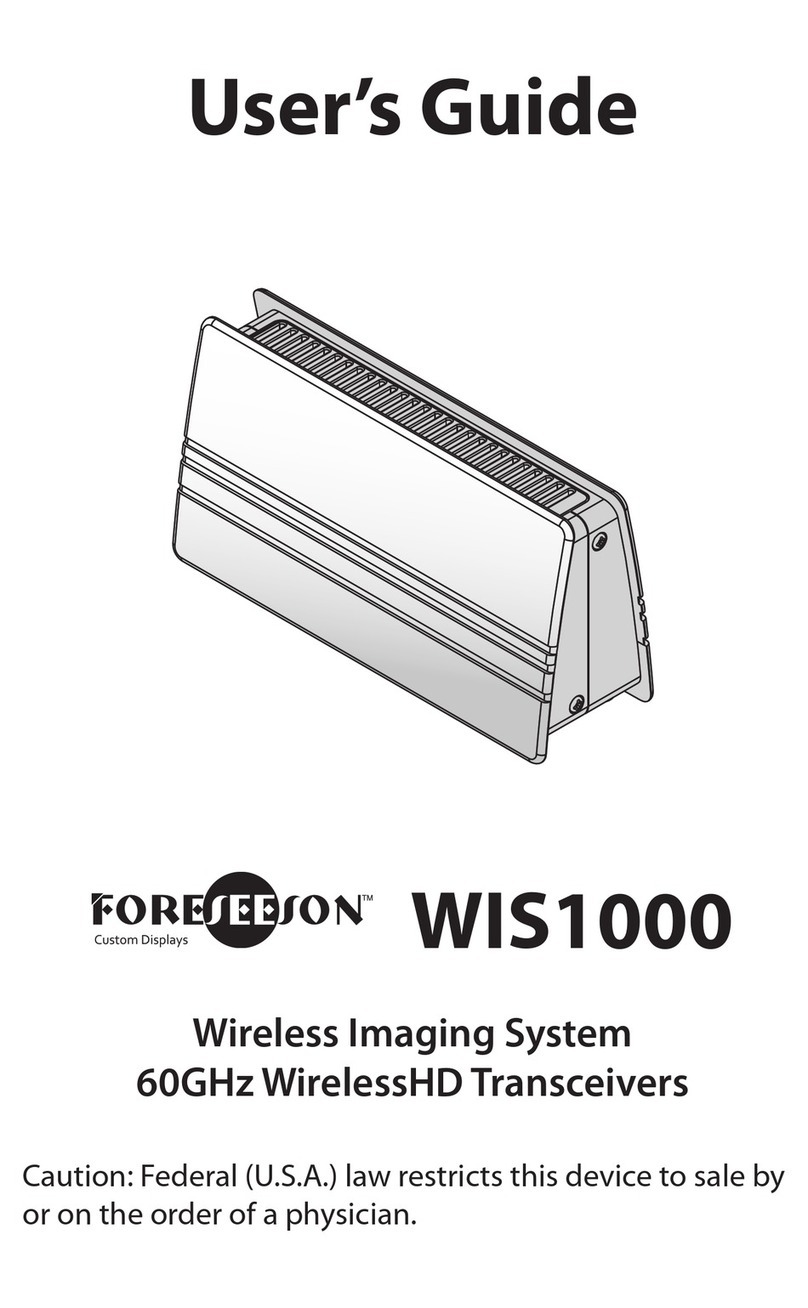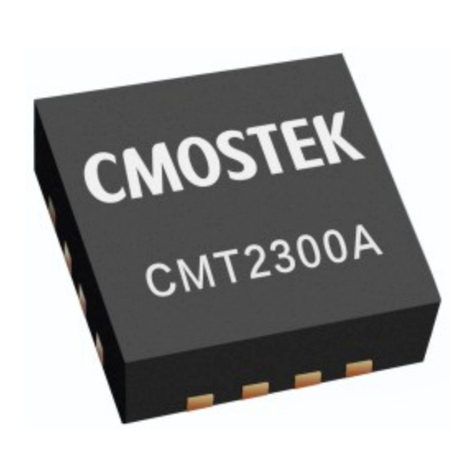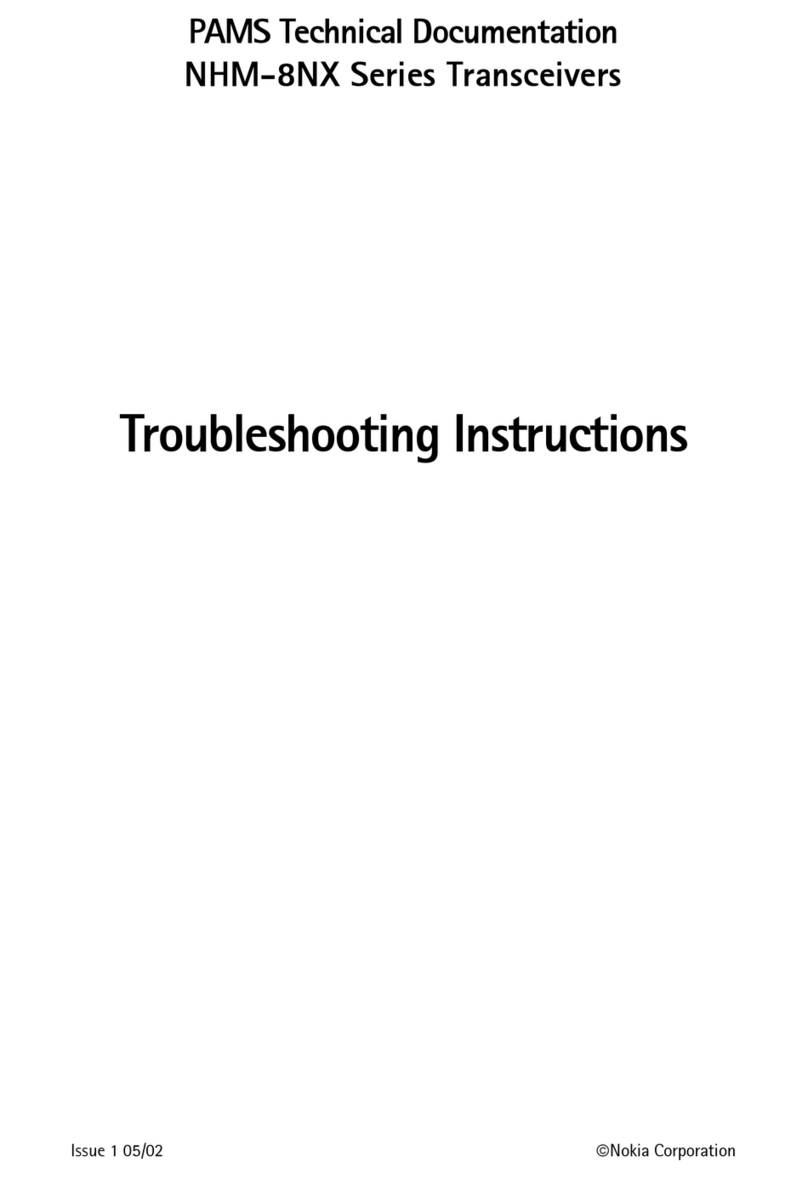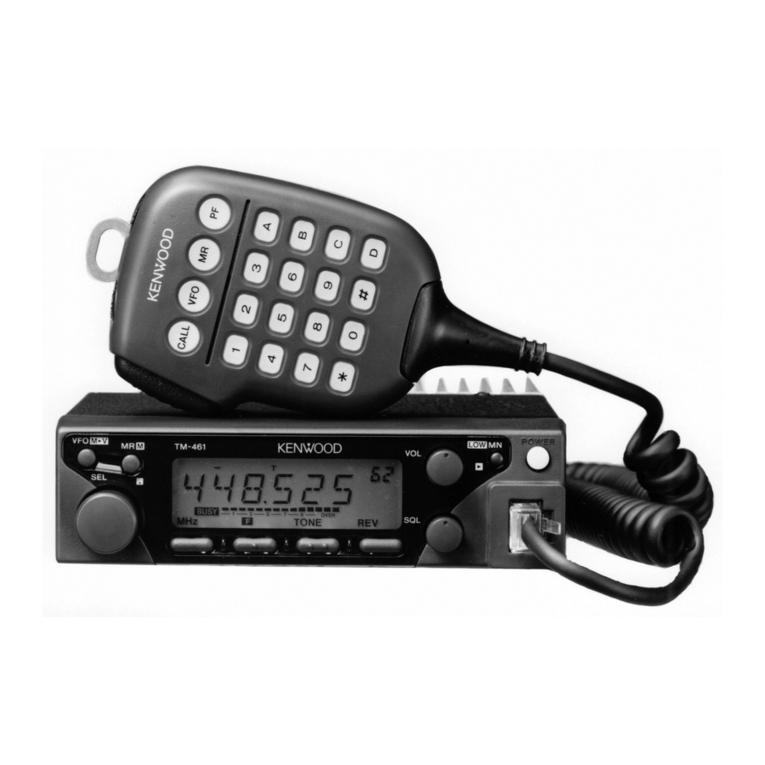TriStar 797 User manual

Operation Manual
Tristar
797
200 Channel Mobile
5-Mode Transceiver

General
Description
The
TRISTAR
797
is
acombination
transmitter-receiver
designed
primarily for
mobile
use.
It
employs
the
very
latest
technology
to
provide
200
channels
of
operation
by
means
of digital
frequency
synthesis
with
PLL
(phase-locked-loop)
circuitry.
The
use
of
PLL
assures
a
precise
on-frequency
operation
on
every
channel
in
both
transmit
and
receive
mode.
The
TRISTAR
797
also
includes
many
other
features
which
will
provide
greater
operating
convenience
and
assure
optimum
communications
under
a
wide
range
of
conditions.
Operable
on
200
channels
divided
into
five
groups
of
40
channels.
3-way
RF
Gain
switch.
Full
noise
reduction
features
-ANL
and
noise
blanker.
5
modes
of
operation
-
CW,
LSB,
USB,
AM,
or
FM
-
selectable
with arotary
switch.
Provision
of
PA.
Concentrically
mounted
Fine
and
Coarse
controls
to
fine
tune
to
any
transmis-
sions
or
operate
in
inter-channel
frequencies.
Tone
switch
to
select
receive
tonal
quality
in
2-way.
RF
power
output
switchable
in
3-way
for
required
communication
range.
TX
lamp
that
indicates
you
are
on-the-air.
External
speaker
jack
for
an
extra
sound
source.
Electrically floating
chassis
for
negative
or
positive
ground
operation
without
switching,
Ahigh-sensitivity
dynamic
microphone
equipped.
CAUTION
FOR
REPLACEMENT
OF
THE
FUSE
IN
DC
POWER
CABLE,
PLEASE
BE
SURE
TO
USE
3,5A
FUSE.
2

Channels.
Frequency
space.
Emission.
Power
source.
Receiver
Specifications
General
Frequency
composition.
PLL
synthesizer
Frequency
range.
A -
26.065
to
26.505
MHz
B -
26.515
to
26.955
MHz
C-
26.965
to
27.405
MHz
D-
27.415
to
27.855
MHz
E-
27.865
to
28.305
MHz
200
10
kHz
AM/FM/USB/LSB/CW
13.8
V
DC
Sensitivity.
Selectivity.
Audio
Output.
Fine
Tune
range.
Coarse
Tune
range.
Squelch
range.
I
ntermed
iate
frequency.
Transmitter
AM
- 1
micro-V
@
10
dB
SIN
FM
- 1
micro-V
@
20
dB
SIN
SSB/CW
-
0.5
micro-V
@
20
dB
SIN
60
dB
2W@80hm
±
800
Hz
±5
kHz
0.5
to
300
micro-V
AM/FM
-
10.695
MHz/455
kHz
SSB/CW
-
10.695
MHz
RF
power
output.
High
Mid
Low
SSB/CW
12
W8W 2W
AM
~5W
4W
1W
FM
lOW
7W
2W
SSB
generation.
Double-balanced
modulator
with
crystal
latice
filter
Coarse
Tune
range.
±5
kHz
3

r---------
Operating
Controls
and
Features
(1)
OffNolume
Control
Varies
the
sound
output
from
the
speaker.
Also
incorporates
an
on-off
switch
at
the
extremely
counterclockwise
position.
(2)
Band
Selector
Selects
a
group
of
40
channels
in
five
positions
-
A,
B,
C,
0,
or
E
(200
in
alll.
(3)
Squelch
Control
Used
to
eliminate
any
annoying
background
noise
when
no
signals
are
present.
The
degree
of
sensitivity
to
incoming
signals
is
adjustable.
When
the
Squelch
control
is
rotated
to
the
fully
clockwise
position, it
provides
maximum
squelch;
in
the
fully
counterclockwise
position,
it
provides
minimum
squelch.
(4)
Mode
Selector
Selects
the
mode
of
reception
and
transmission
-
CW
(continuant
wave),
LSB
(lower
side
band),
USB
(upper
side
band),
AM
(amplitude
modulation),
or
FM
(frequency
modulation).
4

•
(5)
Fine/Coarse
Control
T
his
is
concentrically
located
contra
I
that
perm
its
ind
ividual
adj
ustment
of
receiv-
ing
and/or
transmitting
frequencies.
rA!'/
Fine
(inner
knob).
Provides
fine
tuning
of
the
receiver
section.
On
regular
AM
and
FM
reception,
this
will
permit
adjustment
to
off-frequency
transmissions.
In
the
SSB
(either
upper
side
band
or
lower
side
band)
mode,
this
is
used
as
a
voice
clarifi-
er
to
adjust
for
clearer
voice
reception.
This
control
will
not
affect
the
transmitter
frequency.
(
'/
l
Coarse
Tune
(outer
knob).
This
control
operates
in
the
same
manner
as
the
Fine
knob
except
it
provides
adjustment
of
both
receive
and
transmit
frequencies.
(6)
Channel
selector.
A
50·detent
rotary
switch
to
select
any
of
200
channels
in
conjunction
with
the
Band
Selector
switch.
Window
above
this
switch
indicates
the
channel
selected
using
an
LED
(Light-
emitting-diode)
digital
readout.
(7)
TX
indicator
Lights
up
when
transmitting.
(8)
Channel
indicator
A
digital
LED
display
to
show
channel
selected.
Turned
off
when
operating
PA.
(9)
Power
Selector
Enables
you
to
select
the
RF
power
output
of
the
transceiver
in
3
ways:
High.
In
this
position
the
transceiver
produces
full
rated
RF
power
for
maximum
communication
range.
!'.t1iddle.
In
this
position,
the
RF
power
is
medium
level.
low.
In
this
position,
the
minimum
RF
power
output
is
obtained,
may
be
used
for
short
range
communication.
Note.
The
RF
power
output
level
(W)
which
each
position
provides
is
dependent
on
the
mode
of
operation.
See
Specifications
section
for
specific
RF
power
output.
(10)
Tone
Switch
Changes
tonal
quality
in
receiving
in
2
ways:
High.
High
tones
in
the
sound
output
are
emphasized.
Low.
Low
tones
in
the
sound
output
are
emphasized.
(11)
CB·PA
switch
When
set
to
PA
(lever
down)
position,
the
transceiver
acts
as
a
public
address
amplifier.
Before
operating
PA,
you
must
first
connect
an
external
PA
speaker
(8
Ohm,
more
than
2
W)
to
the
PA
Speaker
jack
on
the
unit
rear
panel.
(12)
NB
switch
Activates
the
noise
blanker
circuit
which
is
effective
in
reduction
of
impulse
type
noises
(ignition
noise,
etc.).
5

(13)
AN
L
switch
Activates
the
automatic
noise
limiter
in
the
audio.
The
ANL will
be
effective
in
reduction
of
atmospheric
(discharge)
interference.
(14)
RF
Gain
switch
Selects
RF
Gain
(receiver
sensitivity) of
the
transceiver
in
3
ways:
OX.
In
this
position,
the
receiver
section
provides
maximum
sensitivity
so
that it
can
pick
up
even
weak
signals.
Normally
this
switch
should
be
placed
in
this
position.
Mid.
In
this
position,
the
receiver
sensitivity
is
medium,
and
may
be
used
when
you
desire
to
pick
only
strong
or
fairly
strong
signals.
Local.
In
this
position,
the
receiver
sensitivity
is
minimum,
and
the
receiver
will
pick
up
only
the
strong
signals.
May
be
used
when
receiving
strong
(close)
signals
which
are
causing
overload
in
receiving
sound.
(15)
Meter
Serves
to
dual
purpose
When
receiving,
this
meter
gives
the
relative
strength
of
incoming
signals
in'S'
units.
When
transmitting,
this
gives
RF
power
output
in
lower
scale.
(16)
Microphone
jack
Accepts
plug
from
the
microphone
supplied.
The
jack
has
a
locating
key
inside
and
allows
the
plug
inserted
in
only
one
way.
Do
not
force
the
plug
but
align
key
way
properly
onto
the
Jack.
(17)
Microphone
Supplied.
With
transmit
pushbar
(PTT)
mounted
at
the
left
side.
®®@
@ @
6

Rear
Panel
Connection
(1)
Antenna
Accepts
a
PL-259
type
coaxial
connector
from
the
antenna
lead-in
cable.
(2)
CW
Key
jack
Accepts
a
3.5
mm
2-conductor
phone
plug
to
connect
a
CW
key.
(3)
External
Speaker
jack
Used
to
connect
an
external
speaker
(8
Ohm
4
W)
as
an
extra
sound
source.
Inser-
tion
of
the
plug
from a
speaker
will
silence
the
internal
speaker
automatically.
(4)
PA
Speaker
jack
Used
to
connect
a
PA
speaker
(8
Ohm
4
W)
for
PA
operation.
Before
operating
PA
you
must
first
connect
a
PA
speaker
to
this
jack.
(5)
13.8VDCjack
13.8
V
DC
power
for
the
transceiver
supplied
through
this
socket
(using
DC
power
cable
supplied).
7

Fine
Control
Opeation
This
control
provides
fine
tuning
of
the
receiver
by
±
0.8
kHz.
On
regular
AM
or
FM
reception,
this
will
permit
slight
adjustment
of
your
tuning
in
cases
where
the
received
signal
is
slightly
off-frequency.
For
SSB
reception,
this
control
is
used
as
a
voice
clarifier
by
turning
it for
clearest,
most
intelligible
voice.
Coarse
Tune
Ca.ntrol
Operation
This
control
acts
like
a
VFO
(variable
frequency
oscillator)
allowing
inter-channel
reception
and
transmission.
This
shifts
the
assigned
center
frequency
of
the
channel
5
kHz
up
(when
rotated
clockwise
fully)
or
down
(when
rotated
counterclockwise
fully).
In
the
center
position,
the
receiving
and
transmitting
frequency
is
normal
(as
listed
in
the
Frequency/Channel
Chart).
CW
Operation
(1)
Set
the
Mode
selector
to
CW
position.
(2)
Connect
a
CW
key
to
the
CW
Key
jack
on
the
rear
panel.
(3)
To
transmit
with
Morse
codes,
simply
operate
the
key.
Note.
To
transmit
CW,
you
may
not
depress
the
transmit
switch
(PTT)
on
the
microphone.
Morse
Codes
A
B
C
o
E
F
G
H
I
J
K
L
M
N
o
P
Q
R
S
T
U
V
W
x
y
z
10
1·-)
1-'
·1
1-
-,)
(-,
)
(
·1
(.
-)
(-_.
)
()
I,)
I·
---)
(-
-)
(-
,)
1--)
1-
)
1---1
1
--
1
1--
-I
1-
1
(
,)
(-)
I··
-)
I,
.-'-)
I·
--I
(-
-)
1-
--I
(-_.
)
1
2
3
4
5
6
7
8
9
o
(.
----I
(.
---)
(.
--I
(
_)
()
(_.
)
(--
.. I
1---·
)
1----·
)
(-----)

Frequency/Channel
Chart
A·Band
B·Band
C-Band
D-Band
E-Band
MHz MHz
MHz MHz MHz
Channel
Frequency
Channel
Frequency
Channel
Frequency
Channel
Frequency
Channel
Frequency
1
26[)6~)
126S15 126.965 1
27~
1
ft
I
27
865
226.075 226.525 226.975 2
27
AZ5
227.875
326.085 326.535 326.985 327A35 3
27.885
·••.27.905·
426.105 426.555 427.005 427A55 4
526115 526.565
~)
27.015 527A65 527.915
G26.125 626.57S 627.025 627A
75
6
27.925
7
26.m
726585 727.035 727.485 727.935
B
26.155
•B26.605 .827.055 r827.505 #8
27.955
'
926165 926615 927.065 927.515 9
27.965
10
26175
10
26.625
10
27.075
10
27.525
10
27.975
11
2G
185
11
26.635
11
27.085
11
27.535
11
27.985
••..
12
26.205
•
12
26655
12
27.105
12
27555
12
28.005
13
262E)
13
26.665
13
27.115
13
27565
13
28.015
14
26.225
14
26.675
14
27.125
14
27
575
14
28.025
15
26.235
15
26.685
15
27.135
15
27585
15
28.035
J26.705 •·.
28
055
•
16
26.255
16
16
27.155
16
27605
16
17
26.265
17
26.715
17
27.165
17
27.615
17
28.065
18
26.275
18
26.725
18
27.175
18
27625
18
28075
19
26.285
19
26.735
19
27.185
19
27.635
19
28085
·.•
..
•
20
26305
20
26.755
20
27.205
20
27655
20
28.105
21
26315
21
26.765
21
27215
21
27.665
21
28115
22
26325
22
26.775
22
27.225
22
27.675
22
,
28.125
23
26355?
23
26.805 \
23
27.255
~
23
27.705 )
23
28.155
~.
24
26.335
24
26.785
24
27.235
24
27.685
24
28.135
25
26345
75
26.795
25
27.245
25
27.695
25
28.145
26
26.365
26
26.815
26
27265
26
27.715
26
28.165
27
26375
27
26.825
27
27.275
27
27.725
27
28.175
28
26385
28
26.835
28
27.285
28
27.
735
28
28.185
29
26395
29
26.845
29
27295
29
27.745
29
28.195
30
26405
30
26.855
30
27.305
30
27.755
30
28.205
31
26.415
31
26.865
31
27315
31
27.765
31
28.215
32
26425
32
26.875
32
27.325
32
27775
32
28.225
33
26.435
33
26885
33
27.335
33
27.785
33
28.235
34
26.445
34
26895
34
27.345
34
27.795
34
28.245
35
26.455
35
26.905
35
27355
35
27.805
35
28255
36
26.465
36
26915
36
27.365
36
27.815
36
28.265
37
2,6475
37
26.925
37
27375
37
27.825
37
28.275
38
2,6.485
38
26935
38
27.385
38
27.835
38
28.285
39
26.495
39
26.945
39
27.395
39
27.845
39
28295
40
2650"
40
26.955
40
27.405
40
27.855
40
28305
--"

.~
'"
E
Q)
-£
en
Popular Transceiver manuals by other brands

Kenwood
Kenwood TK-768 Service manual
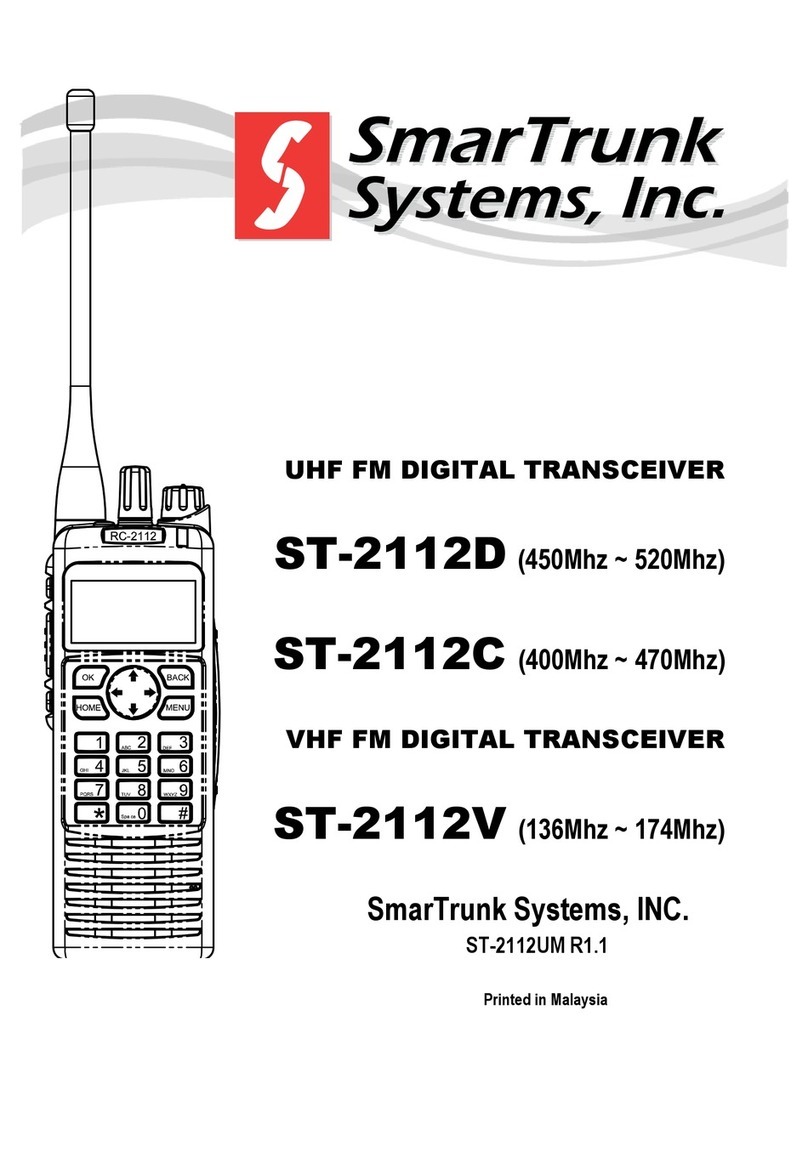
SmarTrunk Systems
SmarTrunk Systems ST-2112D user manual

Ritron
Ritron RPM-050 Maintenance/repair/operating manual

Kenwood
Kenwood 144MHz FM TRANSCEIVER K2E Service manual
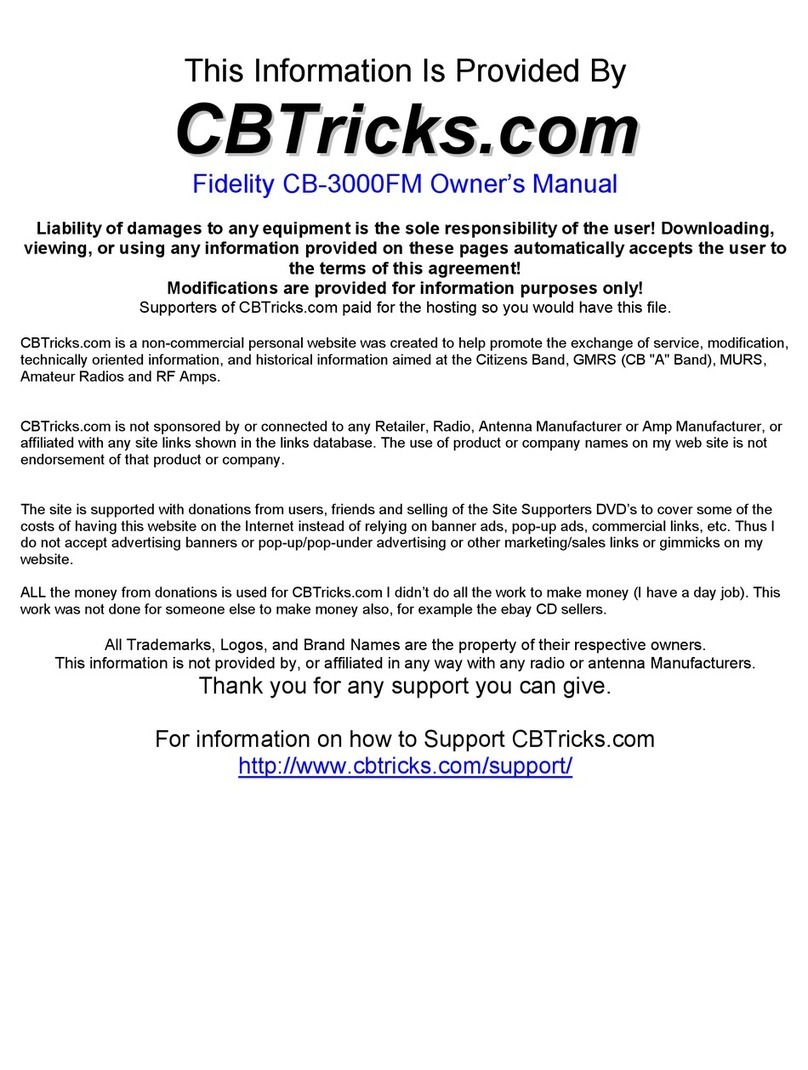
Fidelity Radio
Fidelity Radio CB-3000FM Service manual
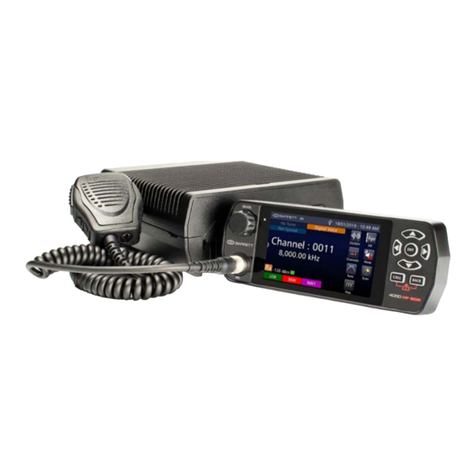
Barrett
Barrett 4050 HF SDR OPERATING AND INSTALLATION Manual
